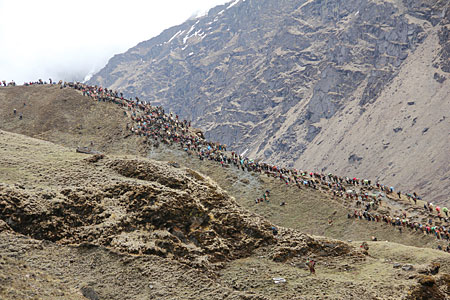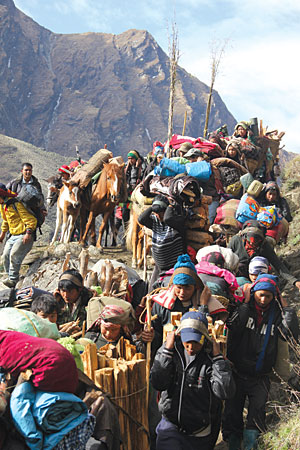 |
Jagraj Pun, 38, took a long breath, prayed to his ancestors and pitched his tent on the banks of the icy cold stream. His wife held their two-year-old son and heat up the raksi jar. This is going to be their home for the next two months, and the family is getting comfortable after a long trek.
Here, in upper Rukum, it is the picking season for yarsagumba, the Himalayan caterpillar-fungus that is worth its weight in gold in China for its supposed aphrodisiac properties. Chinese medicine's demand for this creature is generating income for hundreds of thousands impoverished Nepali villagers from Humla to Gorkha.
Just on this one valley alone,there are 7,000 people, some of whom have trekked two weeks, from various parts of mid-western Nepal. The pickers each pay Rs 1,000 to a committee that organises the harvesting every season and provides security from armed robbers who prey on pickers.
Many like Jagraj have come with their families, entire villages in mid-western Nepal are padlocked during the yarsagumba picking season. The trail is steep and made more difficult by the sheer numbers of people.
At their destination in Pupal Valley, the official yarsagumba picking is declared by opening a gun shot, and suddenly thousands of people fan out like ants up the grassy slopes. It is strictly 'first come first gets' because yarsa harvests decline steadily in the two months that the pickers are here.
On the first day itself Dharmajit Pun of Pelma in Tukum found 45 caterpillars, a family of six found 30, Nainkala of Thabi in Rolpa found only one, and 19-year-old Hiramati of Ranma in Rukum hadn't found a single caterpillar even by the end of the second day.
Yarsagumba from Rukum and Dolpo are big and bright yellow and fetch the best prices. One kg of yarsgumba is worth Rs 30,000 here, but is Rs 100,000 in Kathmandu and US $8,000 by the time it gets to Shanghai. Yarsagumba worth Rs 1.4 million in Kathmandu was harvested here last year from this valley alone. An average family of four can earn up to Rs 140,000 in the two months they spend up here, but they have to spend about a quarter of that in food.
Old-timers say yarsagumba harvests are declining and there will come a time soon when the caterpillar-fungus and butterflies that they metamorphose from will bexxextinct in these mountains.
 PICS: DIPENDRA BHANDARI The spine of a ridge at 4,100 is where many of the harvesters fall prey to altitude sickness. |
 Yarsagumpa picking season is also a time for young men and women (like these two from Rukum) from all over mid-western Nepal to meet up and find their partners. |
 Standing room only on narrow sections of the trail with mules, men and women all carrying enough food and fuel to last them for two months on the high valley. |
 Mothers fix a net around their dokos so their babies don't fall out. |
 The high camp at Pupal valley |
 Jagraj Pun with his wife and son of Yamakhar in Rukum arrive at the harvesting site after five days of walking, others trek for two weeks from as far away as Rolpa. |
See also:
Gold rush in Dolpa, MAARTEN POST
Potent insurgency, KISHORE NEPAL


